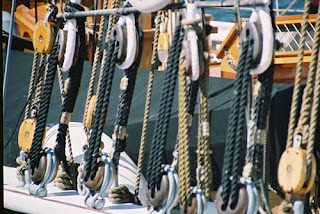As usual, Jenson's book provides excellent detail of the various fittings that make up the business end of the bowsprit.
Bowsprit detail from Jenson's book.
I started with the metal fittings used as attachment points for the bowsprit shrouds and upper and lower bobstays. (These also provide the attachment points for the jib and jib topsail stays, so they have a fair number of attaching options.) As with other metal fittings of this type, I fabricated them from metal strips of copper plate, with attaching points soldered on as necessary. Unfortunately, I neglected to take any shots of the fabrication steps but here are the two end fittings after installation.
Main bowsprit fittings.
Next I fabricated two turnbuckles used in conjunction with the bobstays. Needless to say, they are non-functioning but from a distance, they serve the purpose.
Bobstay turnbuckles.
The other metal fittings were a few more hoops for the bowsprit itself and the small chainstays for the bowsprit back ropes.
Bobstay chainplates and attached back ropes.
After that, I decided to pre-fabricate the safety-net (correct term?) that is slung below the bowsprit. In hindsight, should have waited until I had twine of the appropriate size but instead went with what I had on-hand. The finished rope appears to be a bit on the large size and stiffer than the full-scale item, but again, think I can live with the result. To make the net, traced out the shape on paper and then wrapped the template around a cardboard tube formed into a cone shape. I then laid out the lines and applied white glue at the intersection points.
Bowsprit safety net formed over template.
As can be seen, the end result is fairly rigid! (As an aside, I have not been looking forward to tying the ratlines on the mast shrouds, but this approach seems to yield an acceptable result so it may not be as much of a chore as I anticipated - just have to make sure the lines are the right scale!)
Bowsprit safety net ready for installation.
Now it was merely a matter of assembling all the bits and pieces to make up the bowsprit, including the back rope and the foot rope.
Model bowsprit fitted out.
A couple of notes on the bowsprit before I sign off.
First, according to Jenson, the two bobstays are different n size and both are quite large; the upper is 3-1/2" diameter steel bar and the lower is 4-1/2" steel bar. However, when I mocked up a section of steel wire at the scale size, it didn't look right so I opted to go with a smaller gauge wire, equivalent to roughly 2" diameter for both bobstays.
Secondly, Jenson specifies the four full-scale bobstay shrouds as steel wire rope, 2-1/2" diameter. (The same goes for the two foot-ropes.) While I had access to some small-scale wire rope, I didn't relish the thought of trying to splice the cable to form the loop at each end; in fact, doubt that I could do it in any event. As an alternative, used a suitably sized section of line.
I still doubt that the bobstays were the diameter that Jenson specified. In another diagram, he details the diameter of the end of the bowsprit as eight inches. Here is a shot of the full-scale ship and the bobstays don't look to be twice the size of the shrouds and they certainly don't look to be half the size of the bowsprit!
Full-scale bowsprit - size comparison.
Comparison of full-size and model bowsprit fittings.
Now to figure out what to tackle next.... maybe some deck furniture for a change of pace!
Cheers.



























